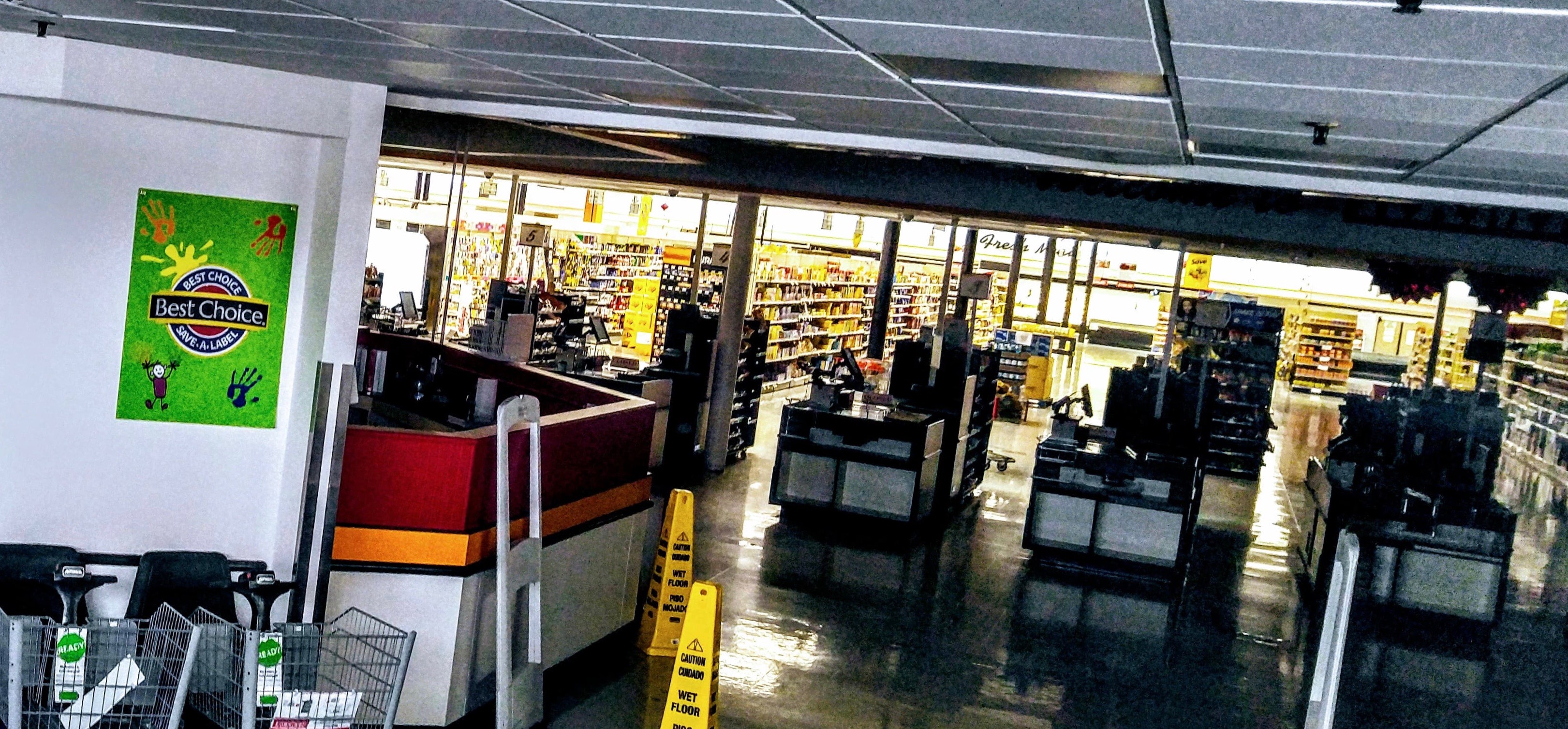By Darlene Carey

Pano shot of Hamady parking lot, now deserted (Photo by Jeffery L. Carey, Jr.)
On the threshold of winter, Hamady Complete Food Center closed its doors at 9 p.m. Nov. 6, fewer than four months since its grand reopening July 25.
Repeated attempts from East Village Magazine for comments from Hamady management went unanswered. When the store opened, owner Jim McColgan Jr. said he had invested the last two and a half years to open up the Hallwood Plaza store in the hopes to combat the food desert that has plagued Flint’s North End. But as it closed, he told TV station ABC-12 the store could not meet financial objectives to sustain it.
And so the “food desert” dilemma continues for thousands of North End residents.
Flint has had its share of hardship with healthy food access after the closure of five of its last six large chain grocery stores within the last decade. According to the website citylab.com, an urban food desert, as defined by the USDA, is predominantly low-income and situated more than one mile away from the nearest grocery store.
Along with the financial difficulty, the 74,000-square-foot grocery store, at 2629 W. Pierson Rd. had experienced its share of delays throughout the building process, with a stop work notice on March 29 because of permit issues, such as “the certificate of occupancy” from the City of Flint and internal problems; and a “bad business partner” according to McColgan at a March 22 press conference.

Check-out lines dark and empty at the now-closed store (Photo by Jeffery L. Carey, Jr.)
North End community members, facing an uphill battle with access to healthy food and diminishing options yet again, have food advocates continuing to unite in light of the troubling development. Sean Gartland, Culinary & Flint Food Works director, said,“I am disappointed on two fronts as it concerns Flint Fresh. One being that the North End of Flint has once again lost access to honest-to-goodness, wholesome food choices from a full service grocery store. On top of that, the employees that had invested their time and hard work into the project are now left without employment.”
Flint Fresh recently opened a food distribution hub on East Court Street. The opening of that $1 million nonprofit food distribution center is designed to expand food options for residents and businesses within Flint city limits to buy locally-grown vegetables for pickup or delivery.
But the Hamady closure is a blow to attempts to expand that network, especially for poorer neighborhoods. Further,the closure means a loss of jobs for a community that badly needs them. When it opened, McColgan said the store was employing 115 people, 55 full time–all now out of a job. Gartland said, “This seems to be the running theme in the area, exodus of business and unemployment followed by loss of choice in the marketplace for consumers.”
Asked what he thinks may be the issue of keeping food sustainable resources in that area of Flint going forward, he said,“For Flint Fresh, the closing of the Hamady store represents one less avenue of opportunity for the food hub operation to partner with. The goal of the food hub is to bring together local farmers and their produce and aggregate it in a way to be able to sell into local markets. Now there is one less business to sell produce to on a wholesale level.”
Flint residents are left wondering if keeping a business in the area is possible. “The issues keeping a sustainable resource like a locally owned grocery store in the area are numerous and unfortunately intricately related,” Gartland explained. “In my opinion it’s a bit of a ‘chicken & egg’ situation.”
Gartland suggested one hardship of infrastructure sustainability is multiple generations of Flint residents not accustomed to the normal conveniences of shopping in an everyday average grocery store. For several years, he noted, Flint had no such business in place.
The system has failed residents with little exposure to the know-how of healthy food choices and nutrition education, he said. “Instead, without access to these healthy food choices, residents are left with no choice but to round out their daily diet with foods that are most commonly found at a corner store or gas station, not to mention the plethora of fast food choices that have filled in the void of grocery stores in many commercial areas of the city.”
Gartland noted the closure again raises questions for businesses thinking about investing in the already poverty stricken area. “As an entrepreneur, do you invest in a grocery concept in the food desert of Flint hoping that eventually the area residents begin to come back to the habits of shopping for weekly groceries? Or do you simply identify more areas of potential profit in the outlying communities to build your store?”
Even with the challenges to healthy food access, Gartland said he hopes for continuing to build resources with a variety of partnerships in the Flint community.
“The only way to keep heading forward and in the right direction is for the people in the community doing the hard work- the pastors supporting community gardens, the agencies promoting healthy eating, the non-profits providing economical support to accessing healthy foods- to continue with their missions and continue to find ways to work together to make bigger gains and more of an impact.”
Will the food desert be the legacy for generations to come?
“As slow as it seems to be going, I think that we are at least starting to all row the boat in the same direction, which is good for the residents of Flint,” Gartland said. “I know that the mission of our organization is taking on these issues with as much grit as we can possibly muster.”
EVM Staff Writer Darlene Carey can be reached at darcar7@hotmail.com.


You must be logged in to post a comment.